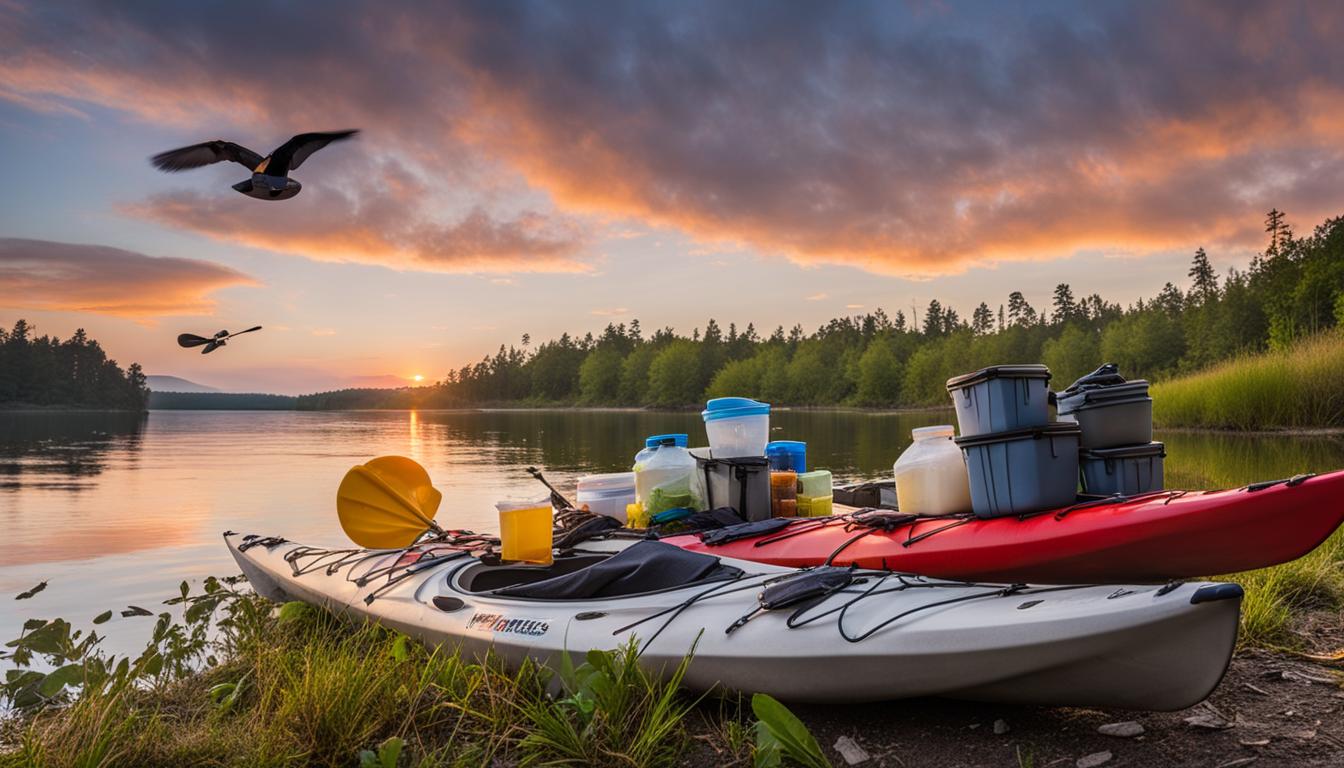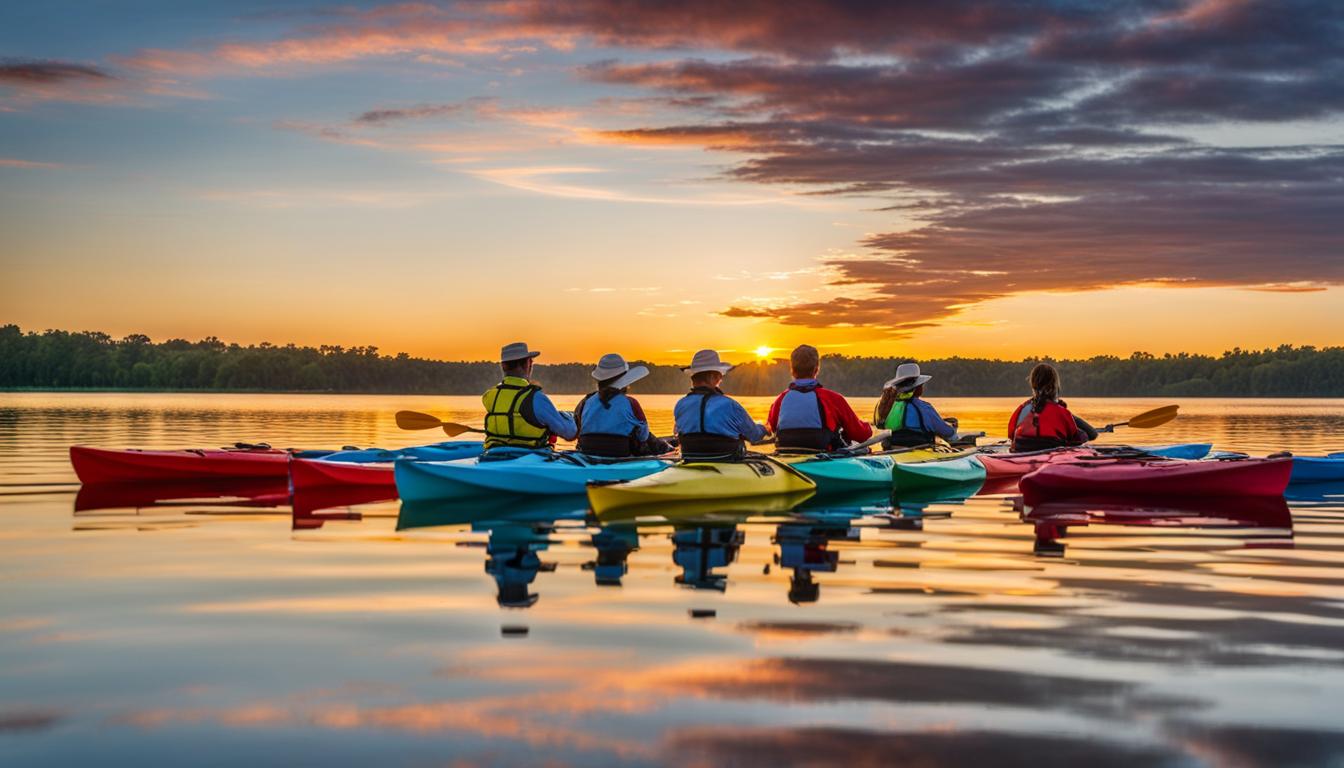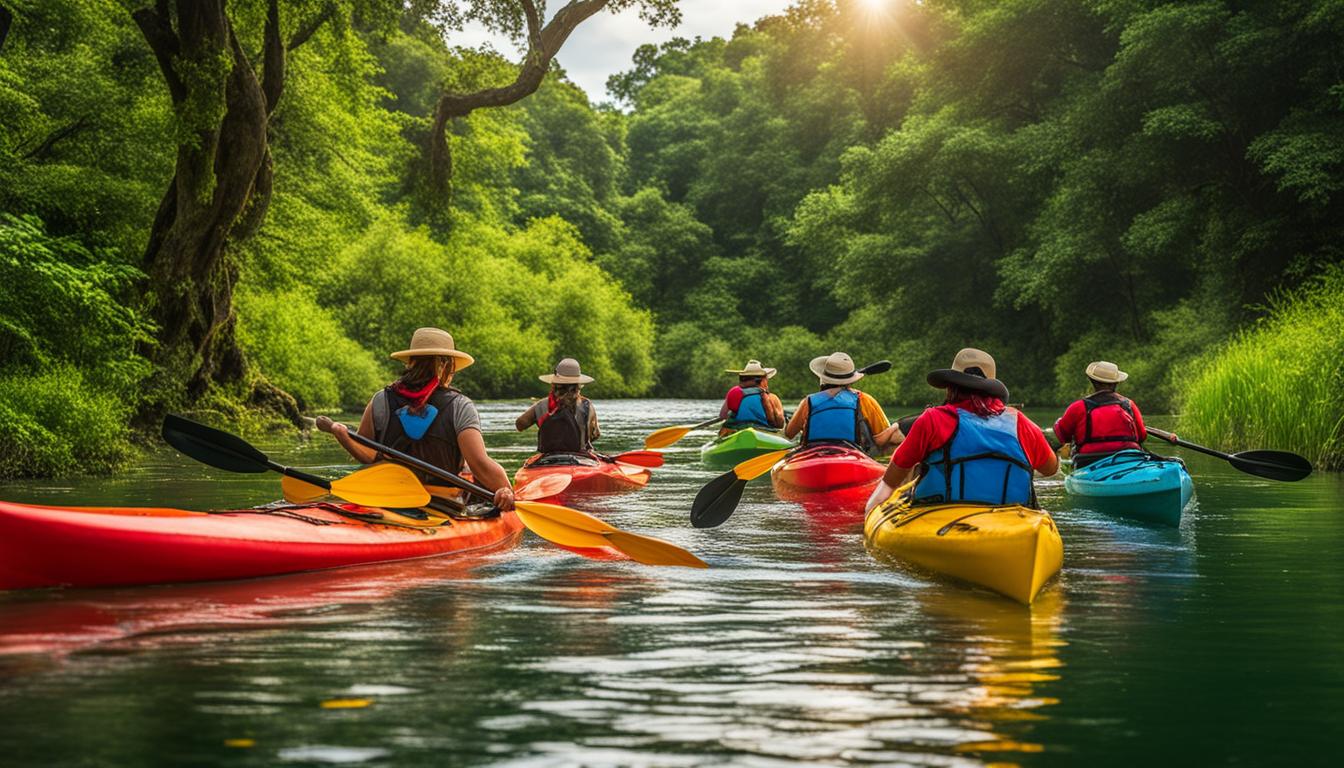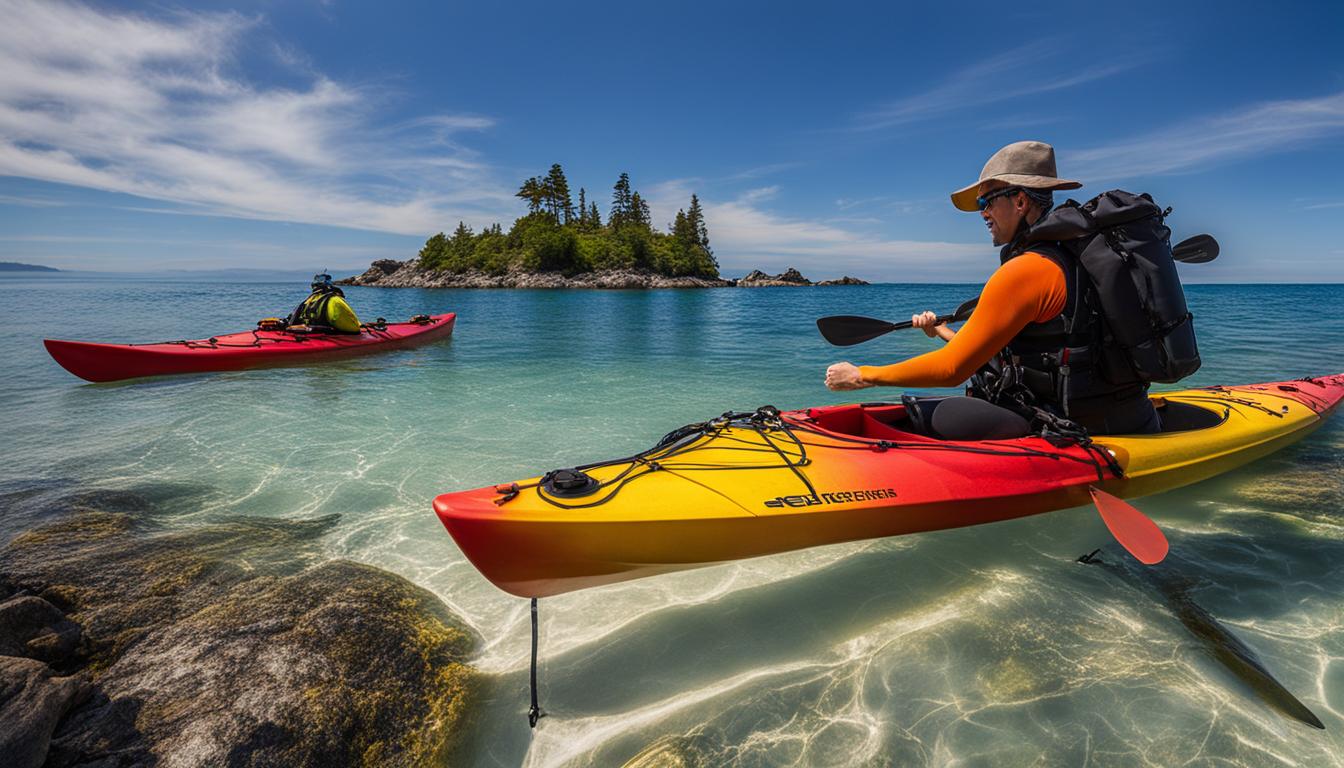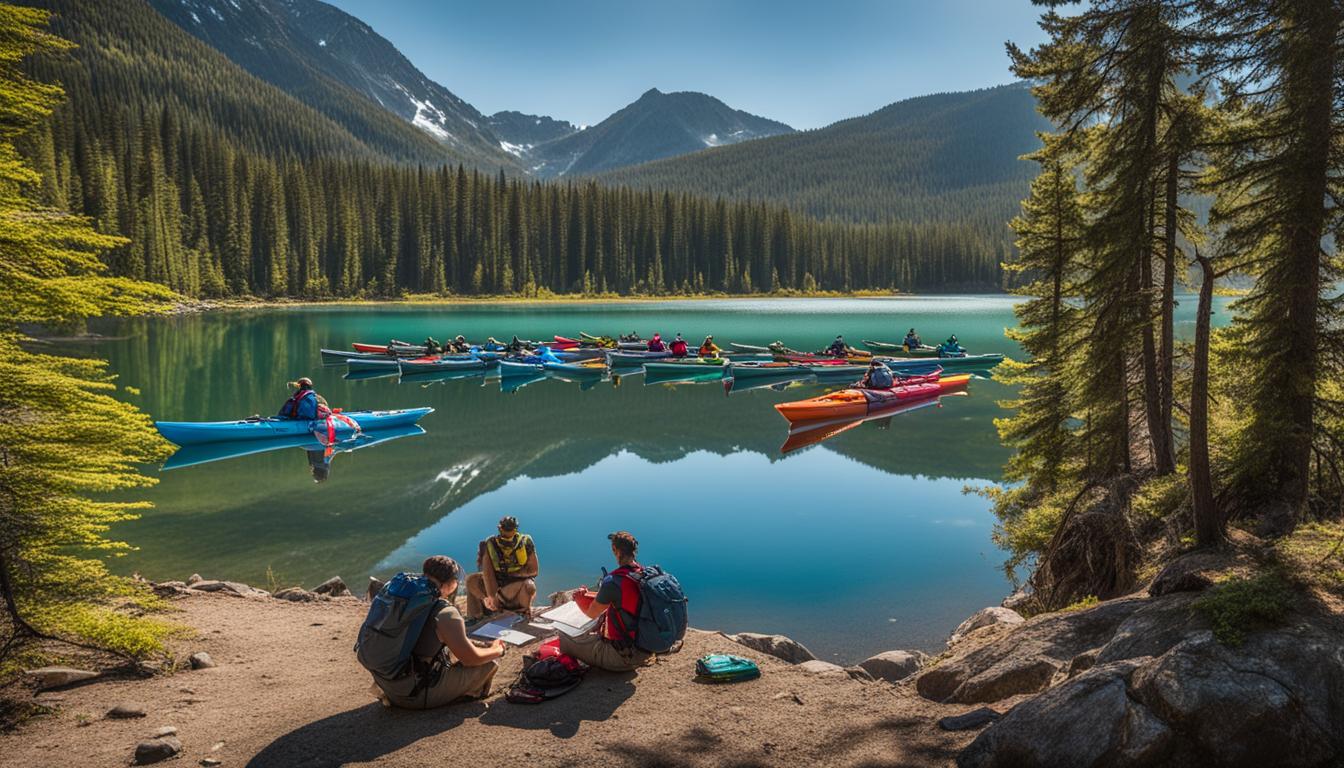Embarking on a kayak trip is an exciting adventure, but it’s important to prioritize safety and environmental responsibility. Properly storing and disposing of food is crucial to avoid wildlife encounters and maintain a clean campsite. In this section, we’ll explore tips and insights on how to pack, store, and handle food on kayak trips to ensure a safe and enjoyable experience.
Key Takeaways:
- Proper food storage is essential for safety and minimizing environmental impact on kayak trips
- Choose the right cooler that fits your kayak and divide it into sections for ice and perishable items
- Maximize food storage efficiency by separating perishable items, utilizing frozen meat as an ice pack, and choosing longer shelf-life foods
- Consider other strategies like keeping items close to the water, freezing water bottles as ice packs, and adding extra insulation to coolers
- Plan your food packing strategy based on the length of the trip and available storage space in your kayak
Choosing the Right Cooler for Kayak Camping
When it comes to kayak camping, selecting the right cooler is essential for keeping your food fresh and safe throughout your expedition. With limited space on a kayak, it’s important to consider the dimensions of your vessel and choose a cooler that fits snugly in the available area. One option is to opt for a medium-sized cooler that offers a balance between storage capacity and space efficiency. Alternatively, you can utilize two smaller coolers to accommodate your food and beverages.
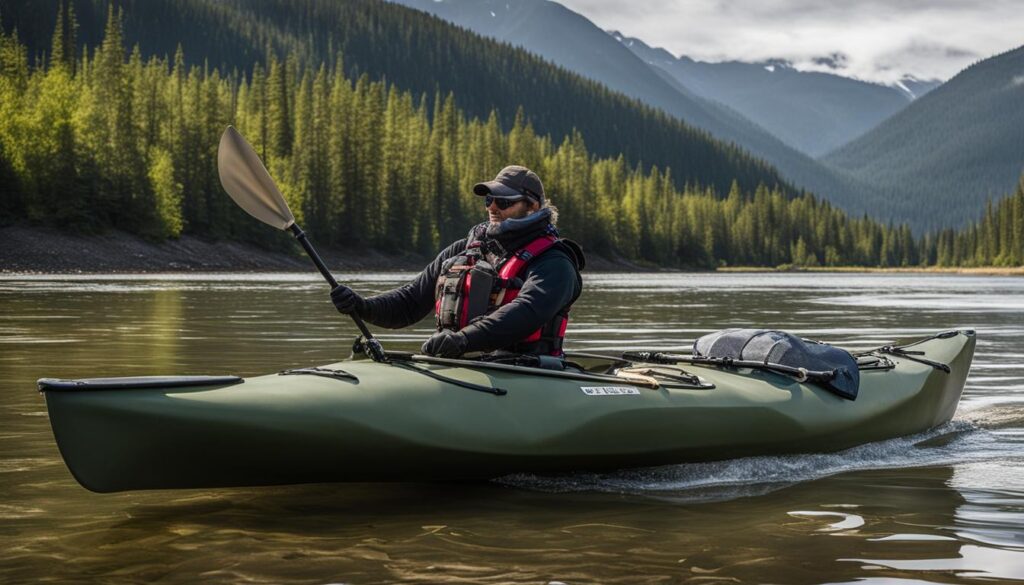
Two popular choices for kayak camping coolers are the Icemule Boss and the Engel roll-top cooler. The Icemule Boss is a versatile option that can be carried like a backpack, freeing up your hands while on the water. It’s also designed to be bear-proof, offering an extra layer of security for your food. The Engel roll-top cooler, on the other hand, features a convenient roll-top closure that provides easy access to your items while keeping them secure and dry.
Once you’ve chosen your cooler, it’s important to organize its contents effectively. Divide the cooler into two sections, using one part for ice and the other for perishable items. Placing ice in a separate compartment ensures that your food stays cold without getting wet or spoiled. Additionally, consider using plastic grocery bags to store food scraps and garbage, keeping them separate from your fresh supplies and maintaining cleanliness throughout your trip.
By selecting the right cooler and implementing smart packing techniques, you can ensure that your food remains secure and fresh during your kayak camping adventure. Remember to choose a cooler that fits your kayak’s dimensions, consider options like the Icemule Boss or Engel roll-top cooler, and organize your cooler’s contents with separate sections for ice and perishable items. With these strategies in place, you’ll be able to enjoy your trip without worrying about food storage issues.
Maximizing Food Storage Efficiency on Kayak Trips
When preparing for a kayak trip, it’s crucial to strategize and maximize food storage efficiency to ensure you have enough sustenance for the entire journey. Whether you’re embarking on a multi-day adventure or a longer expedition, proper packing techniques and storage methods can make a significant difference. Here are some tips to help you pack your food effectively for long kayak trips.
Separate Perishable Items
For longer kayak trips, it’s essential to separate perishable items like meat and vegetables into separate coolers. This not only helps to prevent cross-contamination but also allows for better temperature control. By keeping perishable items in their own dedicated cooler, you can easily monitor the temperature and ensure that they stay fresh for an extended period.
Utilize Frozen Meat as an Ice Pack
If you’re planning to bring frozen meat, consider using it as an ice pack to keep other items cool. This not only helps to save space in your cooler but also ensures that the meat remains at a safe temperature until you’re ready to cook it. Be sure to wrap the frozen meat tightly in a waterproof bag or container to prevent water from leaking into your cooler.
Choose Long Shelf Life Food Items
When packing food for long kayak trips, opt for items that have a longer shelf life. Canned goods, root vegetables, and block cheese are excellent choices as they can withstand varying temperatures and do not require constant refrigeration. Additionally, packing foods that are less prone to spoiling will give you peace of mind throughout your journey.
| Food Item | Shelf Life |
|---|---|
| Canned beans | 1-2 years |
| Dried pasta | 2 years |
| Jerky | 1 year |
| Dehydrated fruits and vegetables | 1-2 years |
By adopting these strategies, you can maximize the efficiency of your food storage on kayak trips. Remember to always pack your food in waterproof containers, utilize cooler space wisely, and store your items in a way that minimizes the risk of attracting wildlife. With careful planning and organization, you can enjoy delicious and safe meals throughout your kayak adventure.
Tips for Safe and Practical Food Storage on Kayak Expeditions
When embarking on a kayak expedition, proper food storage is essential for both safety and practicality. In addition to using coolers, there are several strategies you can employ to ensure your food stays fresh and protected throughout your trip.
Maximize Cooling and Insulation
One tip is to keep your food items as close to the water as possible. This takes advantage of the natural cooling effect, helping to maintain the freshness of your perishable items. Additionally, consider freezing water bottles and using them as ice packs in your cooler. Not only will this keep your food chilled, but as the ice melts, you’ll have refreshing drinking water readily available.
Choose the Right Coolers and Packing Techniques
Choosing the right cooler is crucial for effectively storing food on a kayak expedition. Opt for coolers that offer insulation and are lightweight for ease of transport. It’s also a good idea to divide your cooler into sections, separating perishable items from ice and non-perishable foods.
For longer kayak trips, consider packing non-perishable items that require minimal refrigeration. Canned goods, dried fruits, and snacks like granola bars are great options. These foods will not only last longer but also take up less space in your cooler, allowing you to pack efficiently.
Use Alternative Storage Methods
Aside from coolers, you can also utilize alternative storage methods like hanging food bags. This not only keeps your food safe from wildlife but also saves space in your kayak. Hang your food bags high enough from the ground and away from branches to prevent any unwanted visitors.
By following these tips for safe and practical food storage, you can ensure a successful and enjoyable kayak expedition without having to worry about the safety of your food.
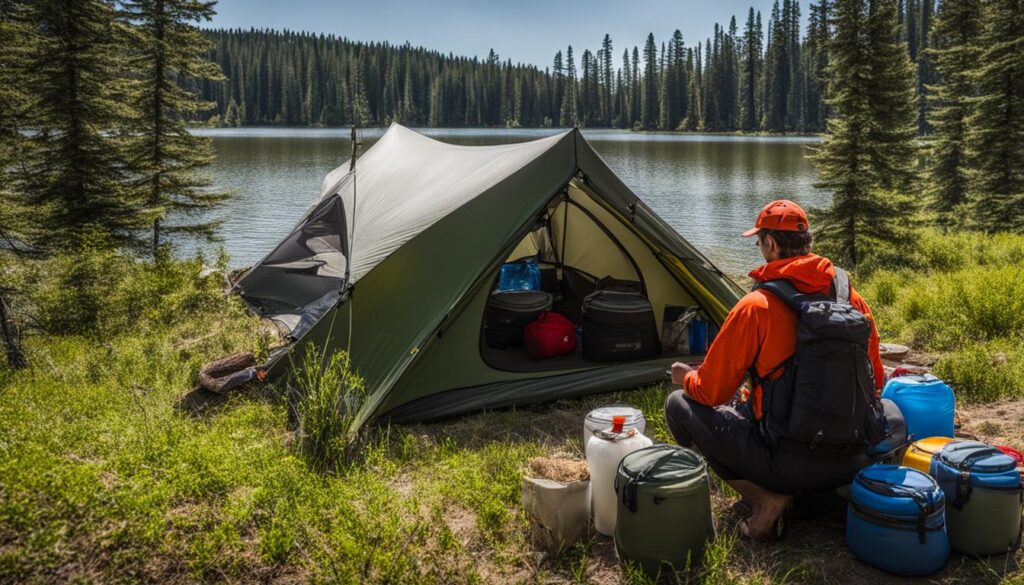
Conclusion
Properly storing and disposing of food on your kayak trips is crucial not only for your safety but also to minimize your environmental impact. By following these guidelines, you can master your kayak trip food storage and enjoy a safe and memorable adventure.
When planning your kayak trip, take into consideration the length of your journey and the available storage space in your kayak. This will help you determine how much food to pack and what storage methods to utilize. Coolers are a popular choice, but you can also opt for alternative options like hanging food bags.
For longer kayak trips, make sure to strategize your food packing. Separate perishable items like meat and vegetables into separate coolers to prevent cross-contamination and extend their freshness. Consider using frozen meat as an ice pack to keep other items cool. Additionally, choose food items with a longer shelf life that require minimal refrigeration, such as canned goods, root vegetables, and block cheese.
By following these tips, you can ensure that your food remains safe and protected throughout your kayak trip. Remember to always store and dispose of food properly to prevent attracting wildlife and minimize your impact on the environment. So pack wisely, paddle safely, and savor your ultimate kayak camping experience!
FAQ
What are some tips for choosing the right cooler for kayak camping?
Consider the dimensions of your kayak and the available space for a cooler. Options include medium-sized coolers or two smaller coolers. Popular choices include the Icemule Boss and the Engel roll-top cooler. Divide the cooler into sections for ice and perishable items and utilize plastic grocery bags for food scraps and garbage.
How can I maximize food storage efficiency on longer kayak trips?
For longer trips, separate perishable items like meat and vegetables into separate coolers. Use frozen meat as an ice pack to keep other items cool. Choose food items with a longer shelf life, such as canned goods, root vegetables, and block cheese. Hanging food bags can also be an option to keep them safe from wildlife.
Are there alternative strategies for safe and practical food storage on kayak expeditions?
Yes, besides using coolers, you can keep food close to the water to benefit from the cooling effect. Freeze water bottles to use as ice packs that can later be consumed as drinking water. Consider adding extra insulation to coolers to prolong the freshness of food. Choose light-colored coolers to minimize heat absorption. Pack non-perishable items that require minimal refrigeration.
Why is properly storing and disposing of food important on kayak trips?
Proper storage and disposal of food are crucial for safety and minimizing environmental impact. It helps prevent attracting wildlife and ensures the freshness and safety of your food during the trip.
How can I plan my food packing strategy for a kayak trip?
Plan your food packing strategy based on the length of the trip and the available storage space in your kayak. Consider using coolers or alternative storage methods like hanging food bags. Choose food items that have a longer shelf life and require minimal refrigeration. By following these guidelines, you can master your kayak trip food storage and enjoy a safe and memorable adventure.

